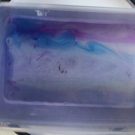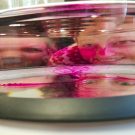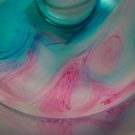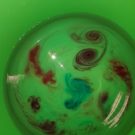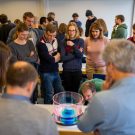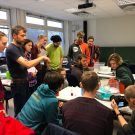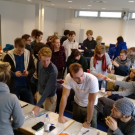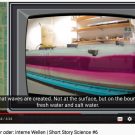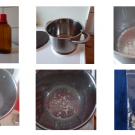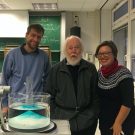Von Jakob Deutloff und Nils Niebaum Es kann schwer sein, sich komplexe physikalische Prozesse vorzustellen. Hier geht es um eine spielerische Lösung. Als Studenten stehen wir regelmäßig vor diesem Problem, besonders häufig im Atmosphären- und Ozeandynamik Kurs. Um uns das Leben etwas zu erleichtern, führt unser Dozent Dr. Torge Martin, unterstützt von Dr. Mirjam Glessmer, dieses […]
Die mysteriöse Kraft, die (Eis)berge versetzen kann
Eine rätselhafte Kraft versetzt (Eis)berge am Nordpol? Als Studierende des Ozeans und der Atmosphäre am Geomar, lassen wir es uns nicht nehmen das Geheimnis um dieses bemerkenswerte Verhalten zu lüften. Folgen Sie uns auf eine spannende Reise von der Vergangenheit bis zu unserem Studienalltag, indem wir mit Tankexperimenten auf der Spur dieses Phänomens wandern. Von […]
Romeo und Julia – zwei Wassertropfen, etwas Farbe und viel Rotation
Was haben der Polarjet, ein Wassertank und Lebensmittelfarbe gemeinsam? Um das zu verstehen, haben wir im Laufe unseres Studiums eigenständig verschiedene Experimente mit rotierenden Wassertanks, Lebensmittelfarbe und Eiswürfeln durchgeführt. Ganz nach dem Motto: Bitte zuhause nachmachen! Ihr seid neugierig geworden, was es damit auf sich hat? Findet es selbst heraus mit der Geschichte zweier Wassertropfen. […]
Blackboard 2.0 – Science in a bucket!
We are a group of undergraduate students studying Physics of the Earth System. We love science. We love that at Geomar we can study super exciting aspects of the Earth System in very small groups. And we love formulas and mathematics, well to a certain extend at least 🙂 This is where the buckets come into play… […]
When you dare say what everybody else is thinking…
Using “One should really play more!” as title of a presentation in a serious scientific colloquium might seem like a bold move, but the gamble payed off: a large, interested audience including everyone from students to professors enthusiastically dropped ice cubes and food dye in our LEGO-driven rotating tanks and passionately discussed their observations. On […]
12 students, four rotating tables, three experiments and one dog
Yesterday we had four rotating in operation simultaneously, running three different experiments. It’s pretty awesome to be able to bridge spin-up times by just observing what the teams on the neighboring tables are up to, also it’s nice to get a variety of experiments all happening at the same time. Very entertaining and educational indeed! […]
Throwback Thursday: Clouds in a bottle
A while back, Susann Tegtmeier and Mirjam ran a PerLe teaching innovation project together. Today, we are reposting a blog post about one of the experiments they implemented. This post was first published on Mirjam’s blog. No one likes clouds when they bring rain, but what if you could make your own? Making a cloud […]
Not just for university teaching: Sharing our experiments with everybody!
Doing experiments like the ones we’ve been doing here is super helpful to let students of ocean and atmosphere sciences find a different way to approach highly theoretical rotating fluid dynamics. But the experiments are pretty and are raising curiosity not only in students, but in most people that see them. To share them with […]
Throwback Thursday: Can you taste the difference? Or how do you estimate salinity?
Today we are looking back at a homework assignment that Joke Lübbecke gave her students 5 years ago, but that’s still interesting & relevant and also a lot of fun! The task is easy: “estimate salinity of this water sample!”. But how do you do that? Here are three different ways to solve the problem Estimating […]
Bringing in more expertise: Playing with Rolf Käse
Yesterday Torge and I spent a fun Friday night trying out new rotating tank experiments together with Rolf Käse. Rolf taught the lab course that got me into tank experiments (back in 2004!) and he’s still such a huge inspiration! Rolf brought his tank which features a conical bottom, and this gives so many more […]
